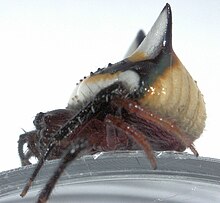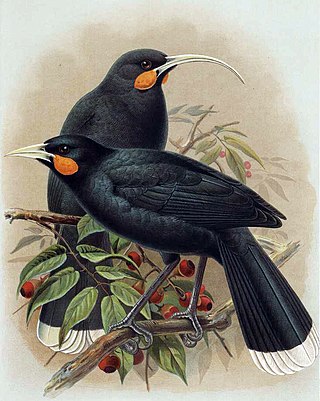
The huia is an extinct species of New Zealand wattlebird, endemic to the North Island of New Zealand. The last confirmed sighting of a huia was in 1907, although there was a credible sighting in 1924.
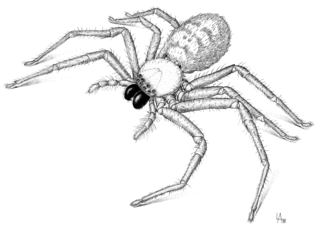
Delena cancerides, the communal huntsman, flat huntsman or social huntsman, is a large, brown huntsman spider native to Australia. It has been introduced to New Zealand, where it is sometimes known as the Avondale spider. This was the species used in the Australian movie Napoleon and widely in Arachnophobia, and all films depict them as having a deadly venomous bite, but they are generally considered harmless to humans in real-life. It was first described by Charles Athanase Walckenaer in 1837.

Austracantha is a genus of spider with a single species, Austracantha minax, commonly known as the jewel spider or the Christmas spider. It is a member of the family Araneidae and is endemic to Australia. They are relatively small spiders, reaching a maximum total body length of only around 12 mm (0.47 in) for females, and 5 mm (0.20 in) for males. Their abdomen has six distinctive projections ("spines") that makes them easy to identify. They are predominantly a shiny black, with variable white, yellow, and orange patterns. Melanistic forms also occur during autumn. They are facultatively gregarious, and can be found in large aggregations of overlapping orb webs. They feed on small flying insects that get entangled in their webs. They are harmless to humans, though the webs can be a nuisance for bushwalkers. They are most abundant during the summer months.

The katipō is an endangered species of spider native to New Zealand. It is one of many species in the genus Latrodectus, such as the Australian redback, and the North American black widow. The species is venomous to humans, capable of delivering a potentially dangerous bite. It is a small to medium-sized spider, with the female having a round black or brown pea-sized body. Red katipō females found in the South Island and the lower half of the North Island, are always black, and their abdomen has a distinctive red stripe bordered in white. In black katipō females found in the upper half of the North Island, this stripe is absent, pale, yellow, or replaced with cream-coloured blotches. These two forms were previously thought to be separate species. The male is much smaller than the female and quite different in appearance: white with black stripes and red diamond-shaped markings. Katipō are mainly found living in sand dunes close to the seashore. They are found throughout most of coastal New Zealand except the far south and west. Katipō feed mainly on ground dwelling insects, caught in an irregular tangled web spun amongst dune plants or other debris.
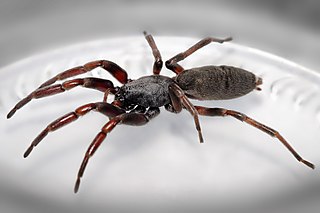
White-tailed spiders are spiders native to southern and eastern Australia, and so named because of the whitish tips at the end of their abdomens. The body size is up to 18 mm, with a leg-span of 28 mm. Common species are Lampona cylindrata and Lampona murina. Both these species have been introduced into New Zealand.

The ʻAhu ʻula, and the mahiole were symbols of the highest rank of the chiefly aliʻi class of ancient Hawaii. The feathered cloaks and capes provided physical protection, and were believed to provide spiritual protection for their wearers. There are over 160 examples of this traditional clothing in museums around the world. At least six of these cloaks were collected during the voyages of Captain Cook. These cloaks are made from a woven netting decorated with bird feathers and are examples of fine featherwork techniques. One of these cloaks was included in a painting of Cook's death by Johann Zoffany.

Steatoda capensis is a spider originating from South Africa. Its common names include the black cobweb spider, brown house spider, cupboard spider and due to its similarities to the katipō spider it is commonly known as the false katipō in New Zealand. Common throughout Southern Africa, it has been introduced into other countries and is now present in Australia and throughout New Zealand. It is a small spider, usually an all-over shiny black. It may have a small bright red, orange, or yellow patch near the tip of the abdomen along with a crescent shaped band near the front of the abdomen.

Trite planiceps, commonly known as the black-headed jumping spider, is a common jumping spider (Salticidae) endemic to New Zealand and one of about 150 species of jumping spiders in New Zealand.
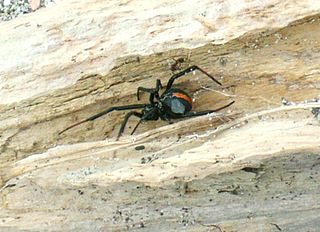
New Zealand has 1157 described spider species, with an estimated total fauna of 2000 species. Over 97 per cent are endemic, and the rest have been introduced through human activities or were natural wind-borne introductions.
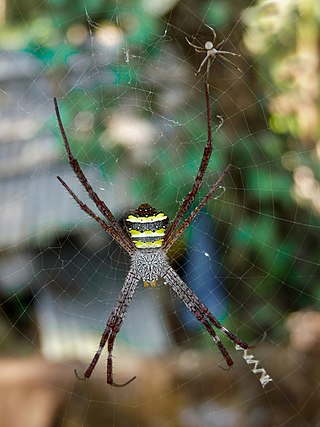
Argiope pulchella is a species of the orb-weaver spider family, Araneidae. It ranges from India to China and can be found on Java. It is a synanthropic species, often living in habitats associated with humans.

Ichneutica maya is a moth of the family Noctuidae. It is endemic to New Zealand. It is found in the mountains in southern half of the North Island and in the South Island. I. maya is a distinctively coloured and patterned moth and as such is unlikely to be confused with similar species. I. maya can be found in the southern half of the North Island down through the South Island. This species can be found in alpine to subalpine zones with high rainfall but in Southland this species can be found down to sea level. This life history in the wild is unknown, nor has its larval host species been confirmed. Adults are on the wing from December to March and are attracted to sugar and light traps.

Meterana pascoei is a moth in the family Noctuidae, endemic to New Zealand. The name and description were published as Morrisonia pascoei by William George Howes in 1912. It is about 38 mm long, with reddish-brown forewings marked with faint lines and a pair of kidney-shaped marks, and a reddish-brown abdomen with a pronounced tuft at the end. Howes named the species in honour of Merlin O. Pasco of Queenstown, who had sent him 20 specimens caught at a treacle-baited moth trap – Howes had previously collected just two specimens, in 1910.
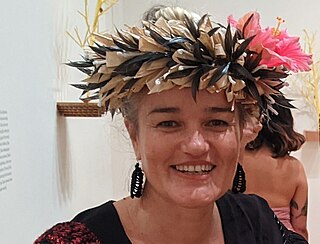
Ani O'Neill is a New Zealand artist of Cook Island and Irish descent. She has been described by art historian Karen Stevenson as one of the core members of a group of artists of Pasifika descent who brought contemporary Pacific art to "national prominence and international acceptance".
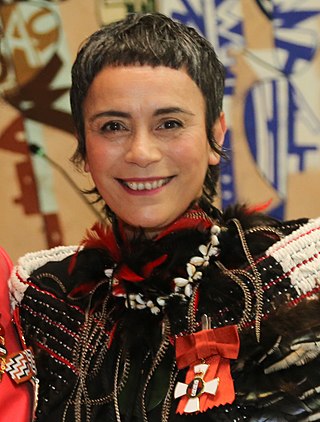
Lisa Marie Reihana is a New Zealand artist. Her video work, In Pursuit of Venus [Infected] (2015), which examines early encounters between Polynesians and European explorers, was featured at the 2017 Venice Biennale.
This is a timeline of the feminist art movement in New Zealand. It lists important figures, collectives, publications, exhibitions and moments that have contributed to discussion and development of the movement. For the indigenous Māori population, the emergence of the feminist art movement broadly coincided with the emergence of Māori Renaissance.
Paul Geoffrey Annear was a New Zealand contemporary jeweller.

Asemonea cuprea is a species of jumping spider in the genus Asemonea that is found in South Africa and Zambia. The spider was first defined in 2009 by Wanda Wesołowska, one of over 500 that the arachnologist described during her career. It is small, generally yellow and lives on the leaves of short shrubs. It has an pear-shaped carapace and a narrower abdomen that each have a length between 1.5 and 1.7 mm. The male has a distinctive coloration with bright orange scales covering the clypeus and eye field and vivid orange hairs on the back half of the abdomen, which are recalled by the species name. The male also has an unusual right-angle shaped subtegulum and the female a simpler epigyne than other Asemonea species that helps identify the species.
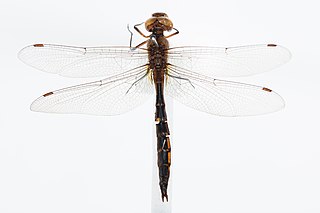
Procordulia smithii, commonly known as Smith's dragonfly or the ranger dragonfly, is a species of dragonfly that is endemic to New Zealand, as is its close relative Procordulia grayi.

Maratus griseus, the white-banded house jumping spider, is a species of jumping spider in the family Salticidae. It is found in Australia and New Zealand.

Hemiandrus brucei is a species of ground wētā in the family Anostostomatidae endemic to New Zealand. They are nocturnal and found in forests in the North Island and northern South Island.
